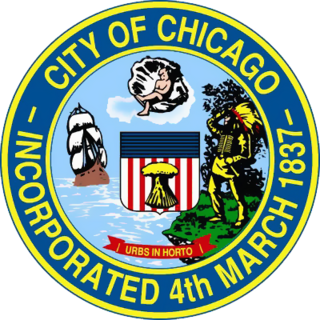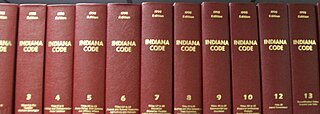Related Research Articles

Medina is a mostly residential city in Eastside, King County, Washington, United States. The city is on a peninsula in Lake Washington, on the opposite shore from Seattle, bordered by Clyde Hill and Hunts Point to the east and water on all other sides. The city's population was 2,969 at the 2010 census. Billionaires Bill Gates and Jeff Bezos, along with a number of Microsoft executives, or other associates of Gates, have homes in Medina.

The Chicago City Council is the legislative branch of the government of the City of Chicago in Illinois. It consists of 50 aldermen elected from 50 wards to serve four-year terms. The council is gaveled into session regularly, usually monthly, to consider ordinances, orders, and resolutions whose subject matter includes code changes, utilities, taxes, and many other issues. The Chicago City Council Chambers are located in Chicago City Hall, as are the downtown offices of the individual aldermen and staff.
The government of the U.S. state of Ohio consists of the executive, judicial, and legislative branches. Its basic structure is set forth in the Constitution and law of Ohio.

The flag of Chicago consists of two blue horizontal bars, or stripes, on a field of white, each bar one-sixth the height of the full flag, and placed slightly less than one-sixth of the way from the top and bottom. Four bright red stars, with six sharp points each, are set side by side, close together, in the middle third of the surface of the flag.

The government of the City of Chicago, Illinois is divided into executive and legislative branches. The Mayor of Chicago is the chief executive, elected by general election for a term of four years, with no term limits. The mayor appoints commissioners and other officials who oversee the various departments. In addition to the mayor, Chicago's two other citywide elected officials are the City Clerk and the treasurer.

The government of Detroit, Michigan is run by a mayor, the nine-member Detroit City Council, the eleven-member Board of Police Commissioners, and a clerk. All of these officers are elected on a nonpartisan ballot, with the exception of four of the police commissioners, who are appointer by the mayor. Detroit has a "strong mayoral" system, with the mayor approving departmental appointments. The council approves budgets, but the mayor is not obligated to adhere to any earmarking. The city clerk supervises elections and is formally charged with the maintenance of municipal records. City ordinances and substantially large contracts must be approved by the council.

The government of the City and County of San Francisco utilizes the "strong mayor" form of mayoral/council government, composed of the Mayor, Board of Supervisors, several elected officers, and numerous other entities. It is the only consolidated city-county in California, and one of only thirteen charter counties of California. The fiscal year 2019–20 city and county budget was approximately $12.3 billion.

Zoning in the United States includes various land use laws falling under the police power rights of state governments and local governments to exercise authority over privately owned real property. The earliest zoning laws originated with the Los Angeles zoning ordinances of 1908 and the New York City Zoning resolution of 1916. Starting in the early 1920s, the United States Commerce Department drafted model zoning and planning ordinances in the 1920s to facilitate states in drafting enabling laws. Also in the early 1920s, a lawsuit challenged a local zoning ordinance in a suburb of Cleveland, which was eventually reviewed by the United States Supreme Court.

The Indiana Code is the code of laws for the U.S. state of Indiana. The contents are the codification of all the laws currently in effect within Indiana. With roots going all the way back to the Northwest Ordinance of 1787, the laws of Indiana have been revised many times. The current approach to updating Indiana Code began in 1971 when the Indiana Statute Revision Commission began a complete rearrangement. The first official edition of the Indiana Code was published in 1976, and is regularly updated through the Office of Code Revision in the Legislative Services Agency.

Gun laws in Illinois regulate the sale, possession, and use of firearms and ammunition in the state of Illinois in the United States.
The law of Colorado consists of several levels, including constitutional, statutory, regulatory, local, and case law. The Colorado Revised Statutes form the general statutory law.

The law of New York consists of several levels, including constitutional, statutory, regulatory and case law, and also includes local laws, ordinances, and regulations. The Consolidated Laws form the general statutory law.
The law of Texas is derived from the Constitution of Texas and consists of several levels, including constitutional, statutory, and regulatory law, as well as case law and local laws and regulations.
The law of Illinois consists of several levels, including constitutional, statutory, and regulatory law, as well as case law and local law. The Illinois Compiled Statutes (ILCS) form the general statutory law.
The law of Ohio consists of several levels, including constitutional, statutory, and regulatory, local and common law. The Ohio Revised Code forms the general statutory law.
The law of Georgia consists of several levels, including constitutional, statutory, and regulatory law, as well as case law and local law. The Official Code of Georgia Annotated forms the general statutory law.
The law of Washington consists of several levels, including constitutional, statutory, regulatory and case law, as well as local ordinances. The Revised Code of Washington forms the general statutory law.

The law of Connecticut is the system of law and legal precedent of the U.S. state of Connecticut. Sources of law include the Constitution of Connecticut and the Connecticut General Statutes.

The seal of Cincinnati is the official insignia of the city of Cincinnati, Ohio, in the United States. Adopted in 1819, the seal incorporates scales, a sword, and a caduceus. The seal is featured prominently in the flag of Cincinnati and the insignia of city agencies and institutions.
References
- ↑ "Municipal Code of Chicago - Preface". American Legal Publishing. Retrieved 17 November 2017.
- ↑ "Municipal Code". City Clerk of Chicago. Retrieved 17 November 2017.
- 1 2 3 Municipal_Reference_Guy (2 December 2016). "Chicago Municipal Code: How to Find and Research Historical Codes". Chicago Public Library . Retrieved 17 November 2017.
- ↑ "Municipal Code of Chicago adopted". Municipal Code of Chicago. American Legal Publishing. 1-4-010. 28 June 2017. Retrieved 17 November 2017.
- ↑ "Administrative copies – City clerk powers and duties". Municipal Code of Chicago. American Legal Publishing. 1-4-040. 28 June 2017. Retrieved 17 November 2017.
- ↑ "Code revisions – Publication". Municipal Code of Chicago. American Legal Publishing. 1-4-050. 28 June 2017. Retrieved 17 November 2017.